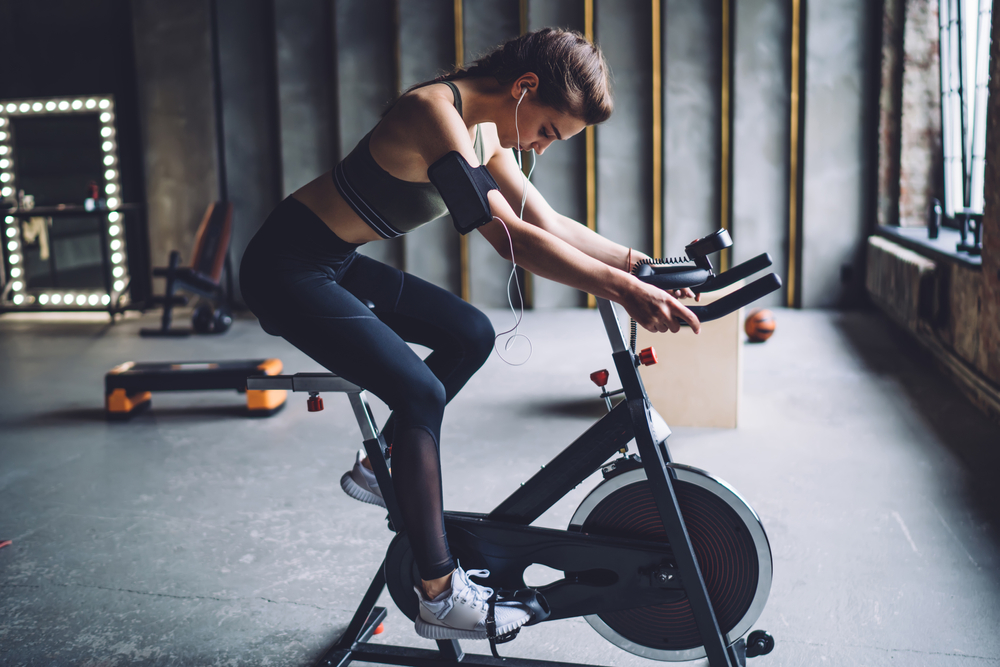Peloton is a recently popular at-home cycling workout. The cycling bike has a monitor screen affixed to the front, allowing you to participate in a variety of live and on-demand classes. During each class, you are given three numbers at the bottom of the screen: cadence, resistance and output. Your output is essentially the intensity of your workout.
The Peloton output number is not based on weight of the user. The power output measures the effort used during the workout. It is a combination of your cadence and resistance numbers. However, people with higher body weight will need to produce more energy to reach the same cadence and resistance, which will result in a higher output number.
In this article, we will explain a few topics regarding the numbers behind your peloton workout. Stay tuned for answers on average output, what effects the output number, and how to increase your output number. Let’s get started!
Contents
What Is Output on Peloton?
The peloton output number is a measurement of the amount of energy used during your workout. The way this is calculated is amount of energy transferred over time. A unit of power is measured in “watts.” Watts can be broken down to one “joule” per second.
Your output will depend on a few different factors, but the most significant ones are cadence and resistance. These are the other two numbers on the screen that combine to equal your output during a workout.
Cadence is the speed at which you are peddling, and resistance is how hard it is to pedal. You can increase your output by increasing your cadence, resistance or both.
We’ll get into the other factors that affect your output throughout this article.
There are two different outputs that you will see, total output and average output. Let’s talk about the differences.
- Total Output: the number of kilojoules that you produced during your entire workout or class. This number will be higher than the average output. Long endurance rides also boost this number.
- Average Output: the number of watts that you are producing in real time. This can be broken down to the amount of energy you are using per second. This number will be lower than the total output, as it is being calculated as you go.
Output is measured in KJ (kilojoules). This is calculated by taking the average output times the number of seconds in the ride divided by 1,000.
Does Weight Affect Total Output on Peloton?
Output while riding the peloton is determined by a number of elements. The most important factors it is based on is your cadence and resistance. This is how fast the pedals are moving, and how hard it is to push them. On top of your cadence and resistance, your age, gender and weight also play a factor. Specifically, we will talk about how weight of the user effects the outcome.
With a heavier body weight, the user will need to use more power to maintain the cadence and resistance. As we know, more power expended during your workout equals a higher output number.
Although someone with a heavier weight will have a higher output number, it is important to note that heavier people fatigue quicker. Those differences may come into play with the total and average output numbers.
Below is a chart that shows different expected outputs based on resistance and cadence numbers during a workout. Notice these numbers are within a range. This is because they will differ based on those other factors specific to your body that we mentioned earlier.
Keeping track of your output is a great way to track your progress and keep you accountable during your workout.
| Resistance | Cadence | Expected Output | Cadence | Expected Output |
|---|---|---|---|---|
| 30 | 80 | 58-62 | 100 | 88-92 |
| 35 | 80 | 83-85 | 100 | 120-125 |
| 40 | 80 | 111-115 | 100 | 160-165 |
| 45 | 80 | 143-146 | 100 | 215-220 |
| 50 | 80 | 186-190 | 100 | 260-265 |
Power-Weight Ratio
So, we know that heavier people need to create more power to maintain the same cadence and resistance. This means that weight of the user will play a large part when it comes to your peloton output number. A higher weight requires more energy to move the body mass against the resistance.
This can be broken down to a power-weight ratio. This is the amount of power that can be produced in relation to body weight. The power-weight ratio is calculated by watts divided by weight in kilograms (kg).
Below is a chart that shows power-weight ratio using watts/kg.
To convert your weight from pounds to kilograms, you can quickly multiply your number in pounds by 0.45359237 kg.
| Weight in KG | 100w | 130w | 160w | 190w | 220w | 250w | 280w | 310w |
|---|---|---|---|---|---|---|---|---|
| 50kg | 2 | 2.6 | 3.2 | 3.8 | 4.4 | 5 | 5.6 | 6.2 |
| 60kg | 1.7 | 2.1 | 2.6 | 3.1 | 3.6 | 4.1 | 4.6 | 5.1 |
| 70kg | 1.4 | 1.8 | 2.3 | 2.7 | 3.1 | 3.5 | 4 | 4.4 |
| 80kg | 1.25 | 1.6 | 2 | 2.3 | 2.75 | 3.1 | 3.5 | 3.8 |
| 90kg | 1.1 | 1.4 | 1.8 | 2.1 | 2.4 | 2.7 | 3.1 | 3.4 |
| 100kg | 1 | 1.3 | 1.6 | 1.9 | 2.2 | 2.5 | 2.8 | 3.1 |
| 110kg | 0.9 | 1.2 | 1.4 | 1.7 | 2 | 2.3 | 2.5 | 2.8 |
| 120kg | 0.8 | 1 | 1.3 | 1.6 | 1.8 | 2 | 2.3 | 2.5 |
Is Peloton Easier If You Weigh More?
Peloton output number is not based on weight, but we did find out that those with a higher body mass will use more power to ride. This means that they will have a higher output number.
But we have also learned that endurance is not high for someone who is heavier.
So, whether or not the peloton is easier for those who weigh more is determined by your goals for your ride.
Below is a chart that shows someone’s power-weight ratio at different watts.
| Weight in lbs. | 160w | 190w | 220w | 250w | 280w |
|---|---|---|---|---|---|
| 60lbs. | 2.4 | 2.8 | 3.2 | 3.7 | 4 |
| 70lbs. | 2.3 | 2.7 | 3.1 | 3.5 | 3.9 |
| 80lbs. | 2.1 | 2.3 | 2.7 | 3.1 | 3.5 |
| 90lbs. | 1.8 | 2.1 | 2.4 | 2.7 | 3.1 |
| 100lbs. | 1.6 | 1.9 | 2.2 | 2.5 | 2.8 |
| 110lbs. | 1.4 | 1.7 | 2 | 2.3 | 2.5 |
| 120lbs. | 1.3 | 1.6 | 1.9 | 2.1 | 2.2 |
Average Output for Peloton
The average output for a peloton ride depends on many different things. Peloton offers a variety of classes with different class times, intensities and themes. Of course, participating in a 45-minute HIIT ride will produce a different output number than a 10-minute cool down ride.
We know that age, gender and fitness ability will contribute to this number as well. Below you will find the average watts for various class times:
- 20 Minutes: 150-200 watts
- 30 Minutes: 200-250 watts
- 45 Minutes: 250-300 watts
It is important to note that these numbers are simply an average. You can easily accomplish a higher output number in these timeframes. If you want a higher output number, we suggest participating in a high-intensity or power zone class.
What is a Good Total Output on Peloton?
Figuring out whether your peloton output is “good” is entirely dependent on your personal body and skills. While it can be easy to compare yourself to others using the leaderboard, it is important to remember the many different factors that go into an output number. The output number is a great tool to compare your progress against yourself, not others.
As a generality, you can use the numbers 120-150 as a wattage range to stay in for a “good” output. However, this will vary.
A “good” output to you, may mean something completely different to someone else. For example, a beginner may be proud of themselves for completing a 15-minute beginner’s ride. While someone who has been cycling for years, uses a 30-minute ride just as their warm-up.
Why Is My Peloton Output Getting Worse?
When we work out, there can be a time when we plateau or notice our numbers getting worse. This could be due to lack of proper care on our bodies while training. This includes lack of sleep, lack of time for recovery, overtraining and poor nutrition. An intense workout is not the only thing that goes into being healthy! We have to be mindful of our body and its needs when training hard.
That being said, there may not be a “one size fits all” answer to why your output is getting worse. Take a look at your eating, sleeping and workout habits to see if you could be the culprit of any of the factors above.
Additionally, your peloton output number will increase as you continue to train. Think of this number as a moving target, not a stagnant number. As your ability to ride increases, so will your output!
What Else Affects Output on Peloton?
As we mentioned earlier, there are a number of factors that play into the peloton output number. We have discussed how cadence, resistance and a person’s weight can affect that number. But what else should we be taking into account? Factors such as age, gender, fitness level, workout intensity and power zone. Let’s discuss.
1. Age
Age is a tricky factor. Using a normal frame of thought, it is easy to assume that as we get older, we have less ability physically. This is a fair assumption in most cases. An active 30-year-old has greater power than an active 70-year-old. An “intense” workout may look quite different for people of these ages. That is to say, this is not the rule when it comes to ages. Someone who is very active at 70-years old may be able to out pedal an out-of-shape 30-year-old.
Below is a chart to show the age of individuals and where their average output falls.
| Age Group of Individuals | Share the Output % (Approx.) |
|---|---|
| 18-24 | 2 |
| 25-34 | 28 |
| 35-44 | 37 |
| 45-54 | 22 |
| 55-64 | 9 |
| 65+ | 2 |
2. Fitness Level
Your fitness level is another factor that effects the peloton output number. Simply put, if you have a better physical stamina, you will be able to work out harder. As we touched on briefly in the previous section, a 70-year-old could be in better shape than a 30-year-old. It’s all about your personal level.
3. Workout Intensity
There are a number of different workouts on the peloton. Various times such as 15, 20-, 30-, 45- and 60-minute rides with themes such as HIIT, Groove, Beginner, and Maternity classes. Each of these will produce a different intensity.
This workout intensity will give you a different output. For example, you will never have the same output number for a 20-minute groove ride than you did on your 60-minute HIIT session.
4. Power Zone
In the peloton world, there are seven levels of effort. Some of the instructors will use these to quickly advise you on how hard you should be working at that point in the class. To participate with power zones, you must take a test that measures your Functional Training Threshold (FTP.) Below is a breakdown of the seven zones and what they mean.
- Zone 1 (Active Recovery): FTP of 55% or less. Easiest level, light cadence and resistance
- Zone 2 (Endurance): FTP level of between 55% and 75%. Great for beginners
- Zone 3 (Tempo): 75% to 90% FTP required. This will be for moderate riders, where you really begin to sweat
- Zone 4 (Lactate threshold): 90% to 105% FTP. This is a challenging power zone, not intended for beginners
- Zone 5 (VO2max): 105% to 120% FTP. This is labeled as a very hard work out; this zone is not able to be sustained for an entire workout
- Zone 6 (Anaerobic capacity): 120% to 150% FTP. At the second from the highest level, this is one of the most advanced workouts.
- Zone 7 (Neuromuscular power): 150%+ FTP needed. You have to be an avid peddler for years to reach this!
How Do You Increase Total Output on Peloton?
Increasing your peloton output number is a great goal to have. It is important to know that this can be done gradually, not overnight. There are several things you can do to increase your output. Below are a few of our top tips:
1. Track Macros
Your diet has a large impact in your ability to workout. As we mentioned before, it could be one of the reasons that contribute to your output number being low. With the proper nutrition, our body receives the proper to fuel to complete a challenging workout. When we fill our body with fatty, sugar-y, over-processed foods, we get poor results.
Tracking your macronutrient numbers is a great way to fuel your body for training sessions. This involves measuring your protein, fat, and carbohydrates to targeted numbers specific to your body’s needs.
2. Use Peloton Shoes
Clipping in with shoes designed for the peloton bike are much more beneficial to your workout than using regular shoes. Clipping in allows you to feel sturdier on the bike, which lets you pedal faster and harder. Additionally, wearing peloton shoes allows for a smoother and more aerodynamic ride.
3. Incorporate Strength Training Classes
Your activity off the bike will help your performance on the bike. By incorporating strength training into your off days, you will see an increased performance. Training your core, back, upper and lower body provides a boost that you will see on the bike. That is because each portion of your body is used while cycling.
- Training your core will provide balance and stability while you ride.
- A strong lower body will help you pedal harder and faster.
- Your arms and back are used to hold yourself in place on the bike.
4. Take Classes with Your Favorite Tunes
The key to a great workout is being fully immersed and enjoying yourself. Even peloton themselves say that “mental strength is an essential ingredient.”
The best way to do that? Crank up the tunes!
Music stimulates the part of your brain that controls movement, so great tunes and a great workout go hand-in-hand. You can filter peloton classes by music type to find the one that fits best for your workout. Additionally, each peloton workout allows you to click into the details to see the playlist. This allows you to know each song that will be played during the ride.
5. Take Longer Rides
Longer rides require more power and endurance. This means that your output will be increased during longer rides. Additionally, taking longer classes will build up your aerobic capacity and increase muscular endurance.
Training in the 45 to 60-minute rides range will allow you to maintain a higher output for a longer amount of time.



